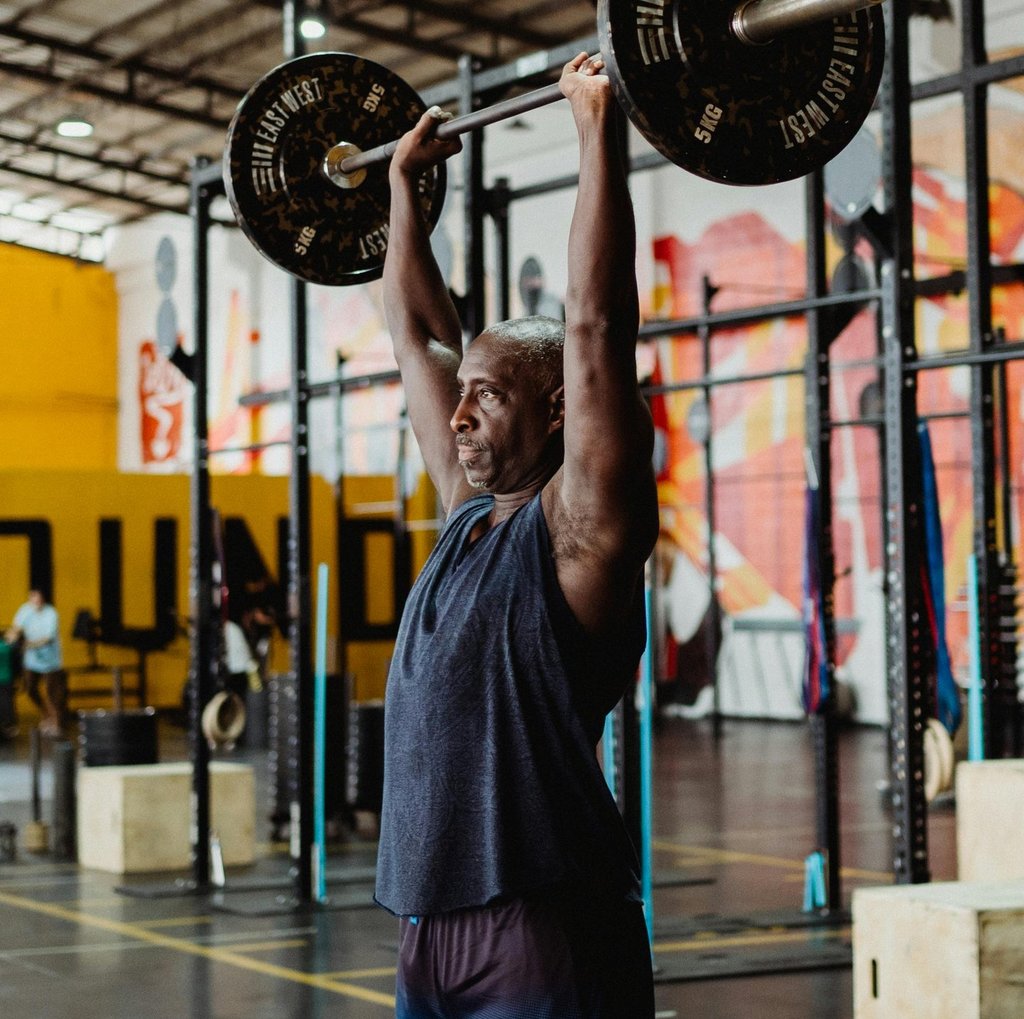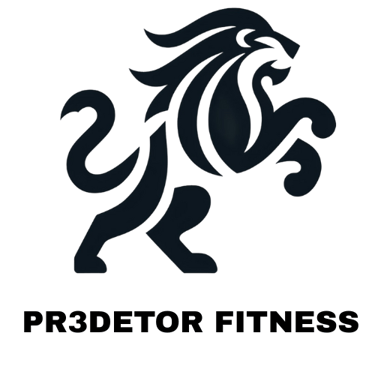The Overhead Press: A Comprehensive Guide to Mastering This Essential Lift
"OHP"
Coach Gabe
1/18/20257 min read


Introduction to the Overhead Press
The overhead press (OHP), also known as the shoulder press or military press, is a fundamental strength training exercise that primarily targets the shoulder muscles, particularly the deltoids. Recognized for its ability to enhance upper body strength, the OHP is a staple in various lifting communities, transcending the boundaries of powerlifting, bodybuilding, and general fitness. This exercise, executed with either a barbell or dumbbells, involves lifting the weight from shoulder level to an overhead position, necessitating not only strength but also stability and coordination.
Powerlifters often regard the overhead press as one of the key lifts, alongside the squat and deadlift. This exercise requires a combination of explosive strength and technical proficiency, making it an essential component of their training regimen. Bodybuilders also embrace the OHP for its effectiveness in promoting muscular hypertrophy, particularly in the shoulders and triceps. The exercise contributes to broader shoulder development, which is crucial for achieving an aesthetically pleasing physique. Casual lifters, on the other hand, benefit from incorporating the overhead press into their routines for overall upper body conditioning and functional strength.
One of the notable advantages of the OHP is its ability to engage a variety of muscle groups beyond the deltoids. While the primary focus is on shoulder development, the lift effectively targets the triceps, upper chest, and even the core muscles, as maintaining stability throughout the movement requires substantial core engagement. Furthermore, the overhead press fosters improved posture and enhances functional strength necessary for everyday activities, such as lifting objects overhead. By incorporating the overhead press into a comprehensive workout program, individuals can harness its full potential, promoting balanced strength development and addressing muscle imbalances.
Historical Perspective and Origins
The overhead press (OHP) has a rich history that dates back to the early days of strength training practices. Widely regarded as one of the foundational lifts in weightlifting, its origins can be traced to ancient cultures where strength was not only a demonstration of physical prowess but also a rite of passage. In ancient Greece, Olympic athletes were known to perform various lifting techniques, including pressing weights above their heads, showcasing their strength and developing their physiques.
Throughout the 19th century, the popularity of the overhead press surged, particularly with the emergence of strongman competitions. Icons such as Louis Cyr and Eugen Sandow began to promote strength training, and they showcased the overhead press as a test of upper body strength and stability. Their demonstration of this lift during public performances helped to further popularize it in the athletic community. The attraction of the overhead press lay not only in its ability to develop muscles but also in the impressive display of power it provided to spectators.
As the sport of weightlifting evolved in the 20th century, the overhead press became a staple in competitive events. Organizations such as the International Weightlifting Federation standardized the lift's technique and established weight classes, which contributed to professional lifting competitions incorporating the overhead press as a key event. During this time, notable athletes like Vasily Alexeyev and Paul Anderson captivated audiences with their incredible overhead press performances, laying the foundation for future generations of strength athletes.
The overhead press has undergone considerable evolution since its inception, including the transition from strict shoulder press styles to variations like the push press and jerk. Today, the OHP remains an essential component of strength training for athletes, bodybuilders, and fitness enthusiasts alike, reflecting both its historical significance and continued relevance in contemporary fitness culture.
Technical Breakdown of the Overhead Press
The overhead press (OHP) is a fundamental strength training exercise that targets the shoulders, upper chest, and triceps. To execute the OHP correctly, one must begin with a proper stance. Stand with your feet shoulder-width apart, ensuring your weight is evenly distributed. This stance provides a stable base, essential for maintaining balance throughout the lift.
Next, the grip on the barbell is crucial for effective performance. Position your hands slightly wider than shoulder-width apart, utilizing a grip that feels comfortable while maintaining control over the bar. Your wrists should be straight and aligned with your forearms, preventing undue strain during the lift. Engage your core to stabilize your body as you prepare to lift the weight.
The movement mechanics of the OHP involve pressing the bar directly overhead in a straight line(slightly different angle with the OHP Push Pres which ends up behind the crown of the head). To initiate the lift, take a breath, brace your abdominal muscles, and then push the bar upward by extending your elbows. Avoid leaning back excessively; instead, maintain a neutral spine throughout the movement. As you press the bar overhead, your head should move slightly backward to allow for an optimal position, then return to a neutral alignment as the bar passes your forehead.
Variations of the overhead press, such as the military press and push press, offer different challenges and benefits. The military press requires strict form with no leg drive, focusing solely on upper body strength, while the push press incorporates a leg drive, allowing for heavier weights to be lifted. Regardless of the variation, avoiding common mistakes is crucial for safety and effectiveness. Beginners should focus on maintaining a controlled motion, avoiding excessive arching of the back, and ensuring the bar travels in a straight line. Proper execution not only maximizes strength gains but also minimizes the risk of injury, making the overhead press a valuable addition to any strength training regimen.
The Importance of the Overhead Press in Powerlifting
The overhead press (OHP) is an integral lift within the powerlifting domain, often regarded as a benchmark for upper body strength. This lift evaluates a competitor's standing strength and stability, demanding a synergy of muscles in both the upper body and core. Within the framework of standard powerlifting competitions, the overhead press is not typically one of the competitive lifts; however, its role in developing strength and performance in bench press and squat performances is undeniable. The overhead press aids in enhancing shoulder strength while developing overall upper body coordination, which translates to safer and more effective execution of other competitive lifts.
The importance of the OHP extends beyond mere muscle gains. It challenges lifters to master body mechanics, demanding proper technique to achieve the desired lift. Proper engagement of the shoulders, triceps, and core not only helps in performing the lift successfully but also minimizes the risk of injury, a crucial aspect in any powerlifting endeavor. This lift requires a solid foundation, making the bench press and the squat more effective as it fosters increased stability and strength in transitions between these lifts.
The Overhead Press in Bodybuilding: A Path to Aesthetics
The overhead press (OHP) plays a pivotal role in bodybuilding, particularly in developing the shoulders and enhancing overall upper body aesthetics. This compound movement targets the deltoids, triceps, and upper pectorals, making it an essential exercise for anyone looking to build a well-rounded physique. A well-executed overhead press not only promotes shoulder hypertrophy but also contributes to the V-taper look that is highly sought after in bodybuilding circles.
To maximize the benefits of the overhead press, bodybuilders can implement various training techniques focusing on volume and intensity. Volume refers to the total amount of weight lifted over a certain period, which can be increased by adding more sets and repetitions to the training regimen. For instance, a common approach is performing three to five sets of eight to twelve repetitions, which helps stimulate muscle growth effectively. This strategy encourages the desired shoulder size, ensuring that bodybuilders can achieve the fullness and definition they seek.
On the other hand, intensity pertains to the amount of weight lifted in relation to one's maximum capacity. A higher intensity can be incorporated by focusing on lower repetitions with heavier weights, often within the range of four to six reps. This method is particularly effective for building strength, which is crucial for progressing to heavier loads in the overhead press. As bodybuilders increase the weights used in their training, they create additional stress on the shoulder muscles, leading to further development.
Incorporating variation in grip, stance, and training angles can also contribute to shoulder development and prevent training plateaus. By using techniques such as the seated overhead press, standing variations, or employing different grips, bodybuilders can target the shoulder muscles from multiple angles, enhancing size and definition.
Overhead Press for Casual Lifters: Building Functional Strength
The overhead press is a fundamental movement that offers various benefits, particularly for casual lifters seeking to enhance their functional strength. Unlike isolation exercises that target specific muscles, the overhead press engages multiple muscle groups simultaneously, including the shoulders, triceps, and core. This multi-joint movement promotes improved strength and stability, which translates into enhanced performance in daily activities.
For everyday fitness enthusiasts, incorporating the overhead press into a workout routine can significantly bolster core strength. A strong core is vital for maintaining proper posture and stability, especially during physical tasks such as lifting objects overhead or performing manual labor. By regularly performing the overhead press, individuals can develop better coordination and body awareness, which are crucial for avoiding injuries in everyday life.
Moreover, the overhead press directly contributes to overall athletic performance. Whether participating in recreational sports or simply playing with children, building shoulder and upper body strength through this lift enables individuals to perform activities with greater ease and efficiency. This functionality is particularly important as individuals age, as it aids in preserving independence and enhancing quality of life.
In addition to its physical benefits, the overhead press fosters mental resilience. Mastering this complex lift requires focus, dedication, and progressive overload — qualities that are transferable to various aspects of life. As casual lifters notice improvements in their strength and resilience, they may find themselves more motivated to pursue their fitness goals and stay consistent in their training regimen.
Overall, the overhead press is a remarkable exercise that promotes functional strength, stability, and athletic performance. By integrating this lift into a standard workout routine, casual lifters can reap numerous benefits, enhancing not only their fitness levels but also their overall well-being.
Conclusion
The overhead press (OHP) stands out as a foundational and versatile exercise within various fitness disciplines. Its significance transcends the boundaries of traditional weightlifting and extends to functional fitness, bodybuilding, and even athletic training. This lift engages numerous muscle groups, including the shoulders, triceps, and core, which makes it a comprehensive movement for building upper body strength. The overhead press can play a pivotal role in enhancing overall athletic performance and improving posture, while also contributing to functional strength that is applicable in everyday activities.
Furthermore, the effectiveness of the OHP in promoting muscle growth and strength development cannot be overstated. Regularly incorporating this lift into one’s workout routine can yield substantial long-term benefits, such as increased muscle mass, enhanced joint stability, and improved lifting mechanics. The engagement of multiple muscle groups not only fosters a balanced physique but also encourages the development of core strength, which is essential for performing everyday tasks safely and effectively.
A key aspect of the overhead press is its adaptability for lifters of all levels, from novices to seasoned athletes. Various adaptations and modifications, such as utilizing lighter weights, performing the lift seated, or different angles enables individuals to tailor their training to meet their specific needs and goals. This versatility allows individuals to approach the OHP from different angles, making it a valuable addition to any training program.
In conclusion, the overhead press is not merely a lift but an essential component of a well-rounded strength training regimen. By incorporating this exercise into training routines, individuals stand to gain both strength and aesthetic benefits. Consequently, embracing the OHP as a staple in lifting practices will undoubtedly contribute to a more effective and fulfilling fitness journey.
